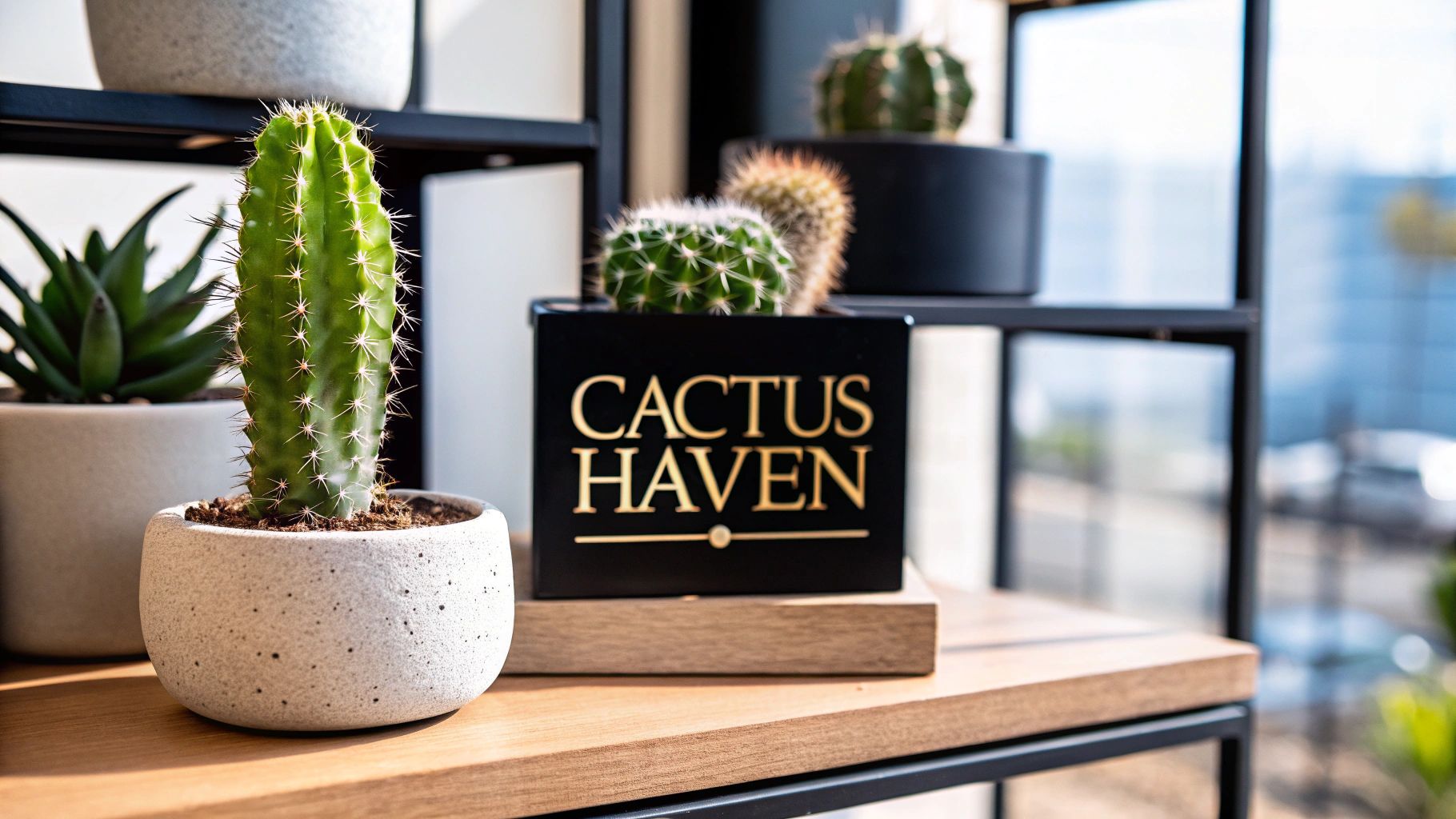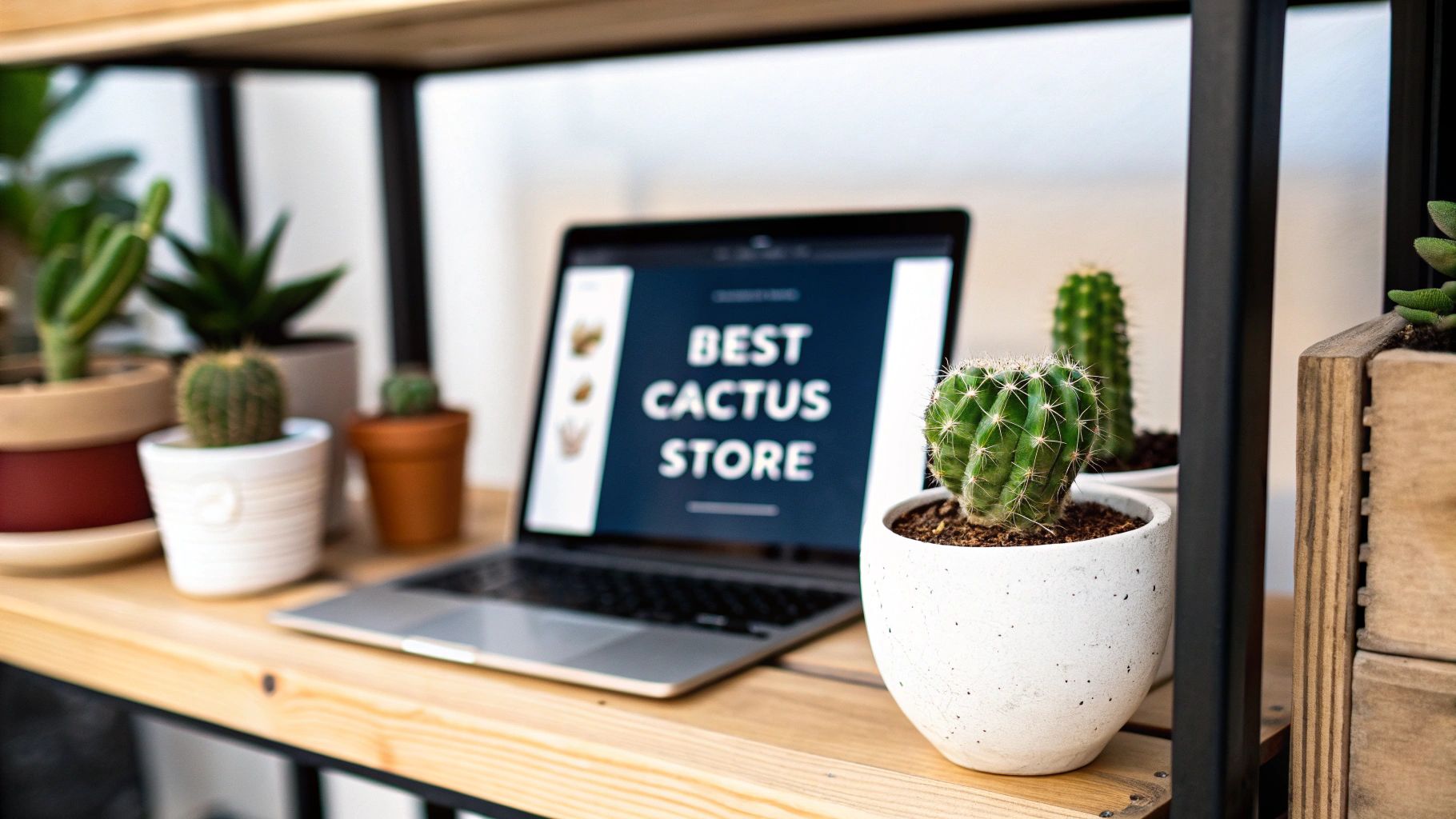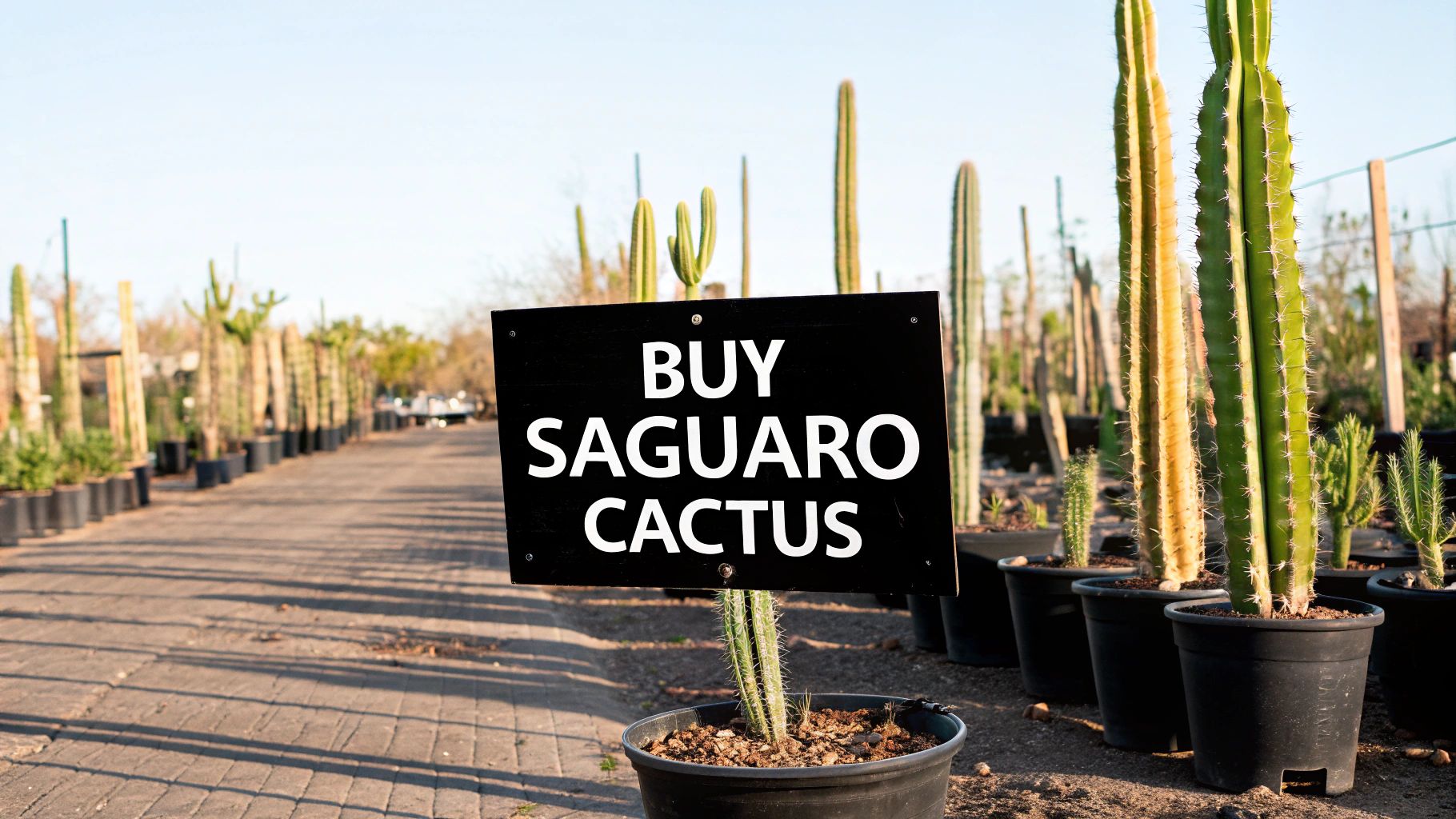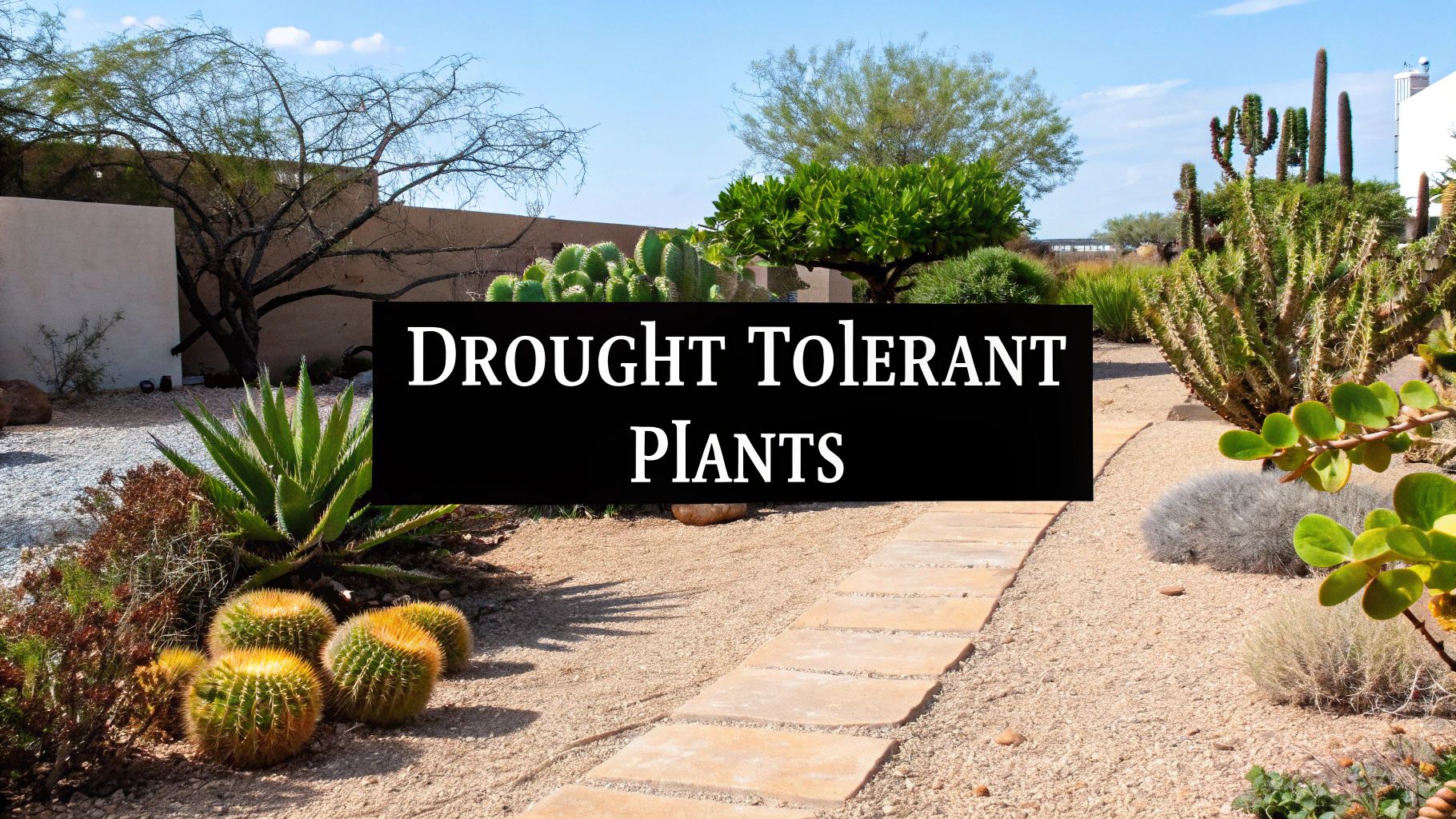Ready to bring the architectural beauty of the desert into your home without the high maintenance? An indoor cactus garden offers a striking, low-water solution that adds a touch of modern, natural artistry to any space. Cacti are more than just prickly plants; they are living sculptures that thrive on neglect, making them perfect for both seasoned plant parents and beginners.
This guide moves beyond the simple potted plant to explore eight distinct and creative indoor cactus garden ideas, showcasing how you can design a breathtaking display that reflects your personal style. We'll provide actionable tips, design inspiration, and practical advice to help you cultivate a unique and thriving desert landscape right in your living room. Whether you're working with a sun-drenched windowsill or a small, shady corner, there's a perfect cactus garden waiting for you to create.
We'll cover everything from enclosed desert terrariums and vertical wall displays to minimalist windowsill collections and imaginative themed gardens. The right container can make all the difference, and for those seeking truly unique and customizable containers, learning how to master the art of the 3D print vase can open up endless possibilities for housing your beautiful cacti. Let’s dive into the concepts that will transform your space.
1. Desert Terrarium Garden
A desert terrarium is a stunning way to showcase cacti by creating a miniature, self-contained desert landscape within a glass container. This popular indoor cactus garden idea goes beyond simple potting, transforming your plants into a living art piece. The transparent walls of geometric containers, classic fish bowls, or vintage apothecary jars offer a 360-degree view, highlighting the unique shapes and textures of your chosen cacti.
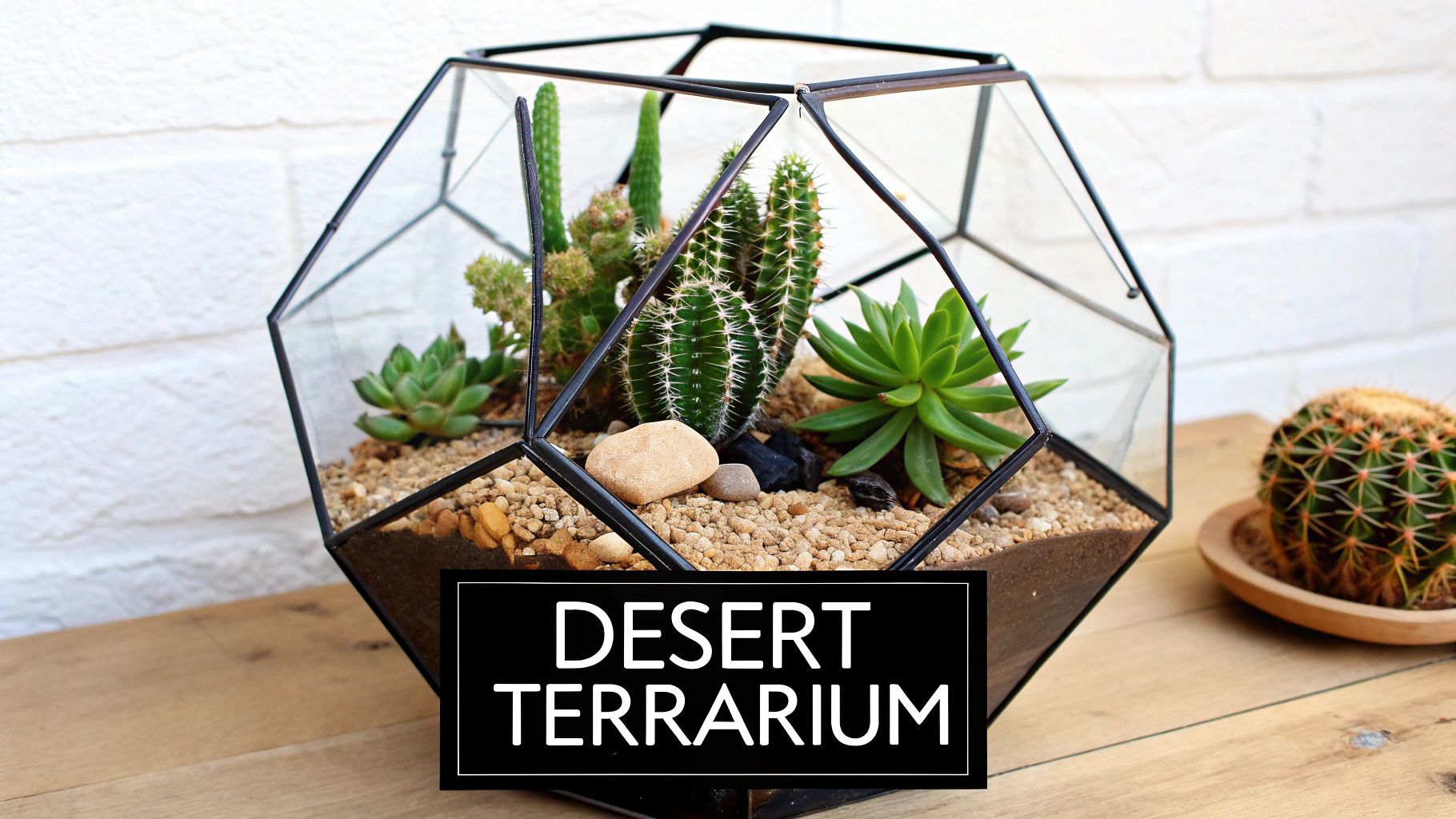
Unlike tropical terrariums that trap humidity, a desert version must prioritize airflow to prevent root rot. This makes them surprisingly low-maintenance while adding a sophisticated, modern touch to any space. Brands like West Elm and specialty shops such as Twig Terrariums have popularized these living sculptures, while plant influencers like Summer Rayne Oakes demonstrate their versatile aesthetic appeal.
How to Create Your Desert Terrarium
Building a successful cactus terrarium requires a focus on drainage and plant selection. Because glass containers often lack drainage holes, creating a proper foundation is crucial for plant health.
- Layering is Key: Start with a one to two-inch layer of gravel or pebbles at the bottom. This creates a reservoir for excess water to collect, keeping it away from the cactus roots.
- Add Activated Charcoal: A thin layer of activated charcoal on top of the gravel helps to filter the water and prevent odors or bacteria from building up.
- Use the Right Soil: Fill the container with a well-draining cactus and succulent potting mix. This specialized soil is designed to mimic the arid conditions cacti thrive in.
- Choose Slow-Growing Cacti: Opt for compact, slow-growing varieties like Mammillaria (Pincushion Cactus) or small Rebutia species. These will maintain their scale within the terrarium for a longer period.
Expert Tip: Always use an open container or one with a large opening. A closed terrarium traps too much humidity, which is detrimental to desert plants. Proper air circulation is the most critical factor for a thriving cactus terrarium.
2. Vertical Cactus Wall Garden
A vertical cactus wall garden is a space-saving solution that transforms an empty wall into a living work of art. This innovative indoor cactus garden idea utilizes wall-mounted planters, felt pockets, or modular systems to arrange cacti and succulents vertically. It creates a dramatic focal point, ideal for apartments, offices, or any room where floor space is at a premium, allowing you to cultivate a diverse collection without clutter.
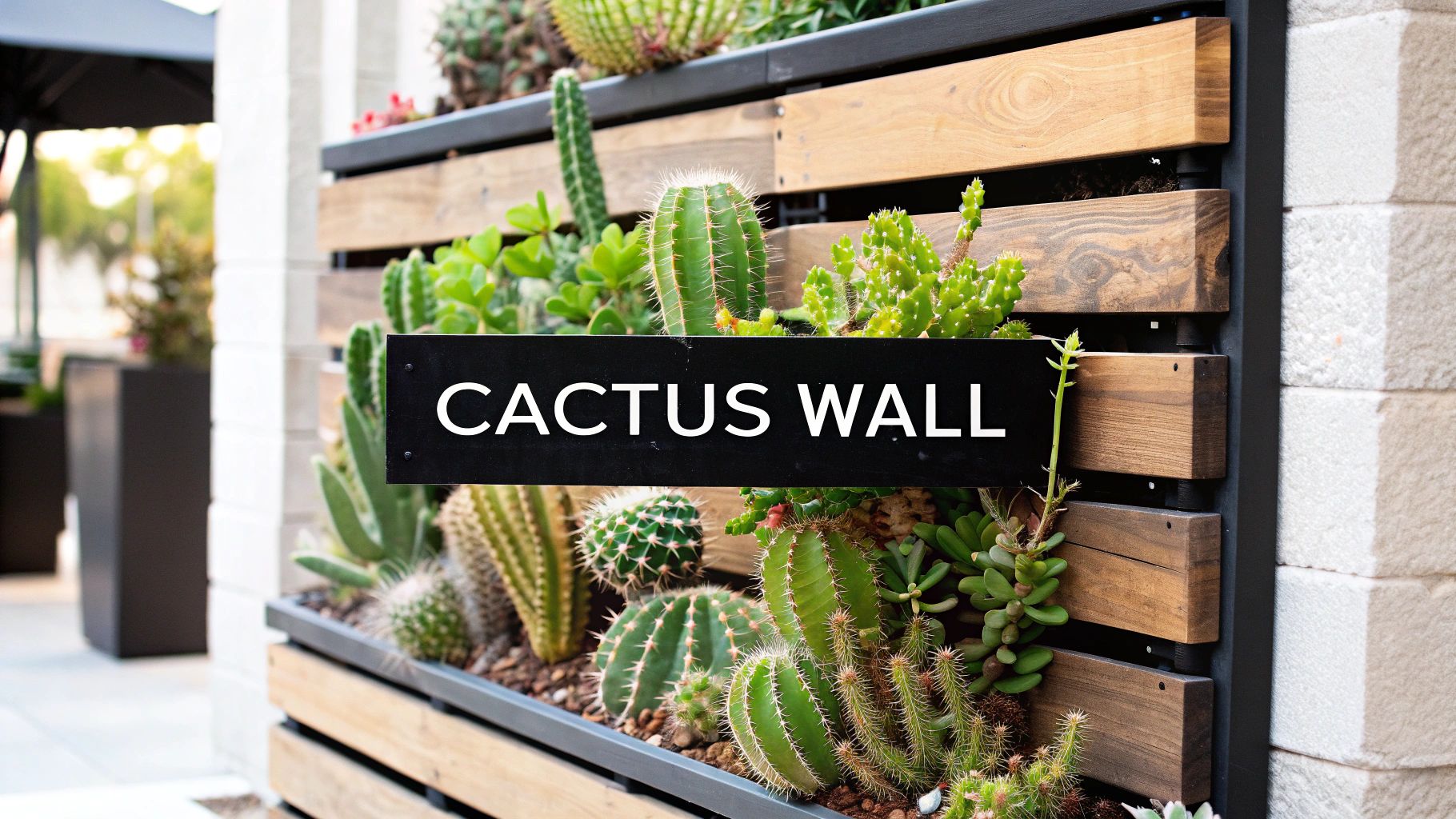
This method showcases the unique architectural beauty of cacti in an organized, grid-like or free-form pattern, turning plants into a dynamic design element. Companies like Florafelt and GroVert have made these systems accessible for home use, while designers like Rebecca Cole have championed their aesthetic potential in modern interior design. The result is a stunning, low-water feature wall that brings texture and life to your home.
How to Build Your Vertical Cactus Wall
Success with a vertical cactus garden hinges on structural integrity, proper plant choice, and a thoughtful watering strategy. Unlike traditional pots, a vertical setup requires careful planning to manage weight and moisture against your wall.
- Protect Your Wall: Before installation, place a moisture barrier behind the framework. A simple sheet of plastic or a custom-cut acrylic panel will prevent any moisture from seeping into and damaging your drywall.
- Choose the Right Plants: Select cacti with shallow root systems that won't require deep soil. Trailing varieties like Rhipsalis (Mistletoe Cactus) or compact species like small Opuntia (Prickly Pear) are excellent choices.
- Ensure Structural Support: The combined weight of the structure, soil, plants, and water can be substantial. Test your wall and use appropriate anchors to ensure it can support at least three times the garden's expected final weight.
- Use Removable Inserts: Opt for a system with individual pot inserts or pockets. This allows you to remove each plant for thorough watering and draining, which is much easier and cleaner than watering the entire wall in place.
Expert Tip: If your wall doesn't receive at least six hours of bright, direct sunlight, install full-spectrum LED grow lights. Position the lights above the installation to mimic natural sunlight and ensure all plants, especially those at the bottom, receive adequate light for healthy growth.
3. Windowsill Cactus Collection
A windowsill cactus collection is a classic and highly effective indoor cactus garden idea, transforming the sunniest spots in your home into a vibrant, curated display. This approach utilizes the abundant natural light of south or west-facing windows to create an ideal habitat for sun-loving cacti. By grouping various specimens along the sill, you can create a beautiful living arrangement that is both decorative and easy to access for care.
This method is celebrated for its simplicity and visual impact, allowing collectors to showcase the diversity of cacti shapes, sizes, and colors. Home decor publications like Better Homes & Gardens and lifestyle blogs such as Apartment Therapy frequently feature stunning reader-submitted windowsill gardens. The key is creating cohesion, whether through a set of matching pots, a specific color palette, or a collection of a single cactus genus like Echinocactus.
This quick reference summarizes the key requirements for starting your own windowsill garden.
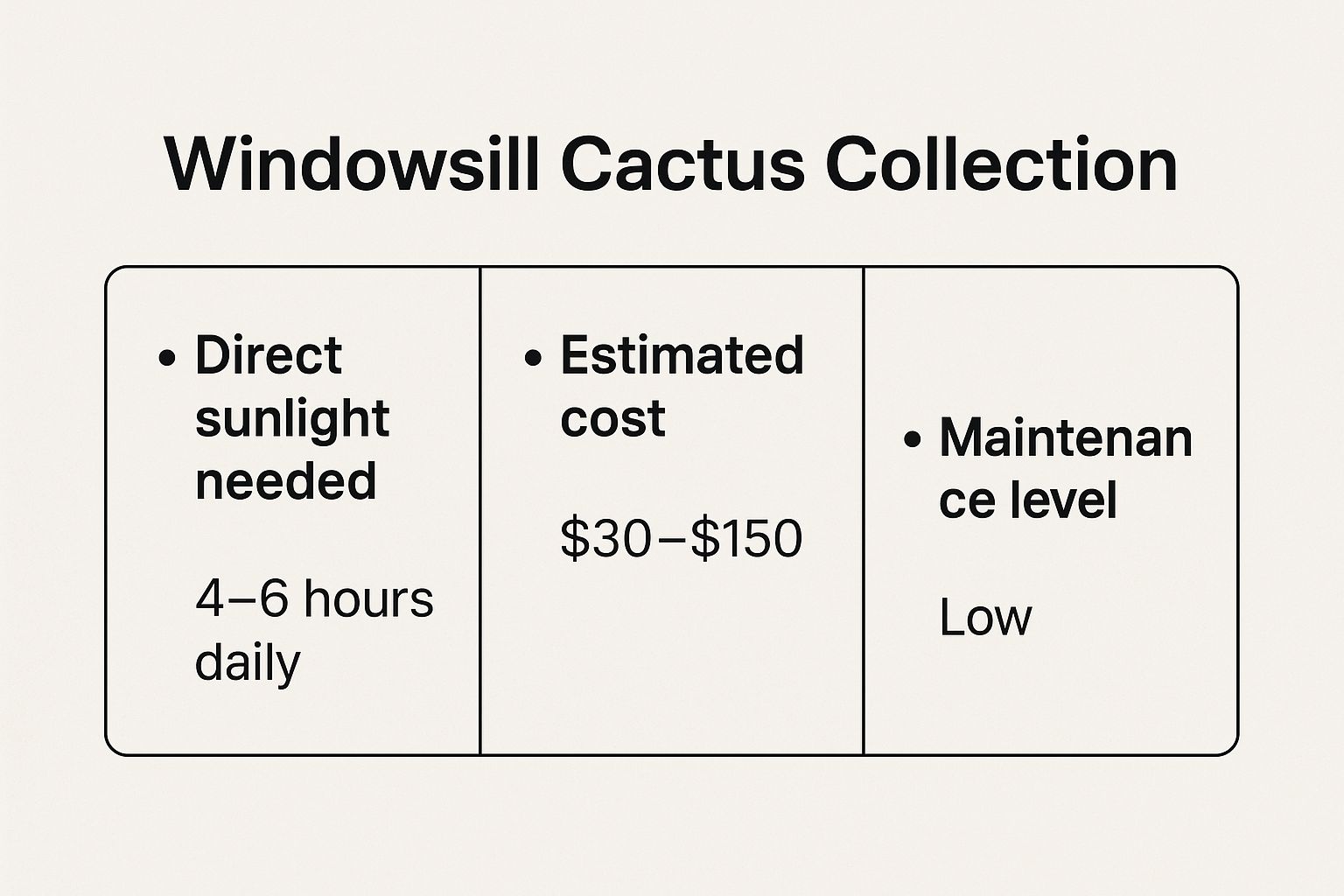
The data highlights that a windowsill garden is a low-maintenance, budget-friendly project, provided your chosen window receives enough daily sunlight.
How to Curate Your Windowsill Collection
A successful windowsill garden balances aesthetics with the practical needs of the plants. Proper plant selection and maintenance are essential to keep your collection thriving. For more detailed guidance, learn more about the best places to put a cactus in your house on cactusoutlet.com.
- Group by Need: Arrange cacti with similar light and water requirements together. This simplifies your care routine and ensures all plants receive the conditions they need to flourish.
- Protect Your Sill: Place a waterproof tray or individual saucers under each pot. This protects wooden or painted windowsills from water damage during watering.
- Rotate for Even Growth: Turn each pot about a quarter-turn weekly. This encourages symmetrical growth and prevents your cacti from leaning towards the light source.
- Monitor Sunlight Intensity: Glass can magnify the sun's rays, creating hot spots that may scorch sensitive cacti. Be mindful of intense afternoon sun, especially in summer, and consider a sheer curtain to diffuse the light if needed.
Expert Tip: To maintain the scale of your collection, choose slow-growing and compact varieties such as Mammillaria gracilis fragilis (Thimble Cactus) or Parodia. These species won't quickly outgrow their space, ensuring your display remains balanced and beautiful for years.
4. Miniature Cactus Rock Garden
A miniature cactus rock garden brings the dramatic beauty of a desert landscape indoors, artfully arranged within a shallow container. This indoor cactus garden idea focuses on creating a naturalistic, meditative display by combining cacti with carefully selected rocks, sand, and other organic elements. The goal is to mimic a slice of arid terrain, transforming your plant collection into a living sculpture that emphasizes composition and texture.
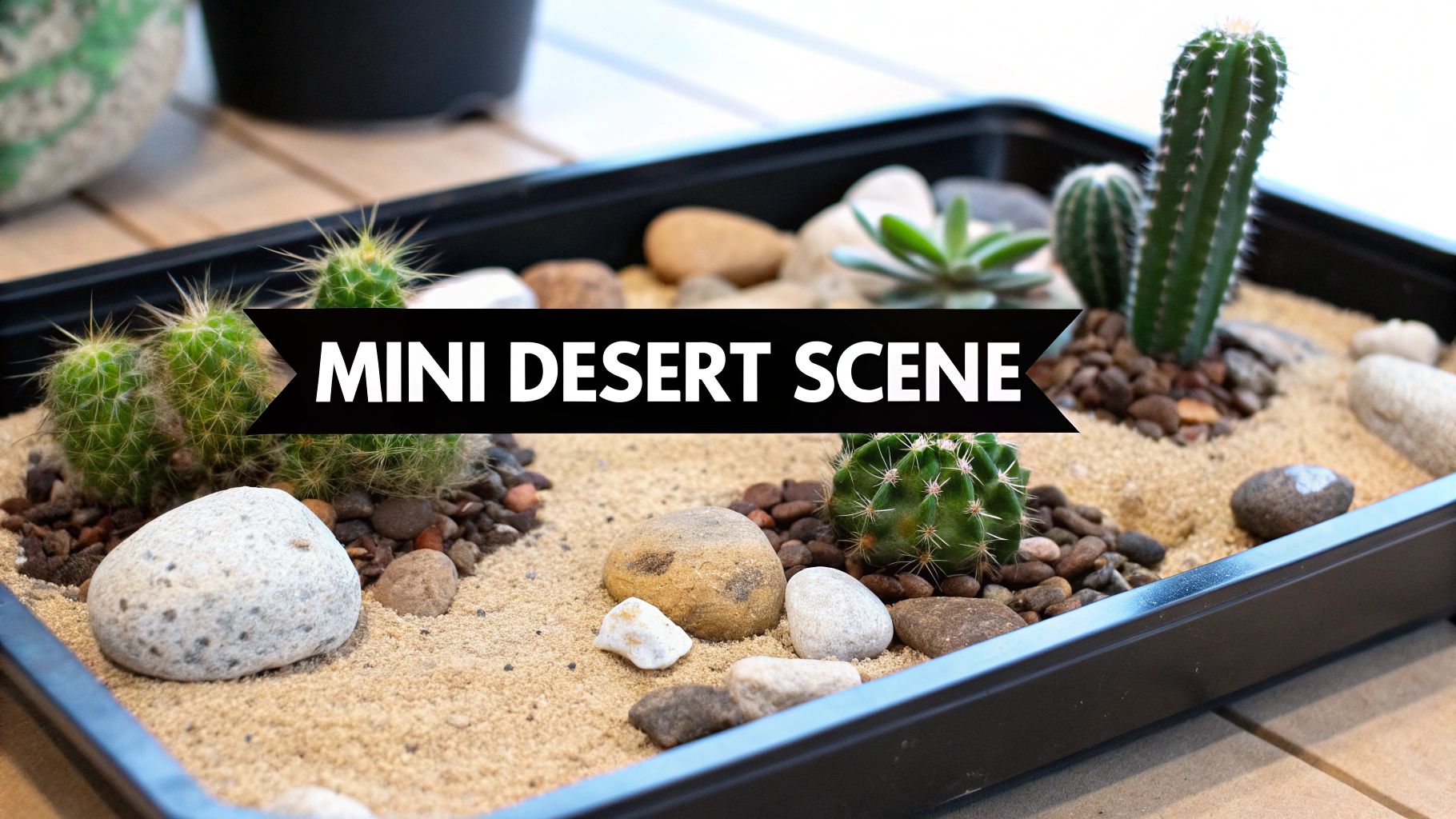
This approach draws inspiration from the principles of Japanese rock gardens (Karesansui) and suiseki, focusing on balance, negative space, and natural forms. Popularized by Etsy artisans creating viral mini desert scenes and creators like Bonsai Mirai showcasing desert landscape techniques, these gardens serve as a compelling focal point. Because of their contained size, they are perfect for tables, shelves, and even smaller homes where you need to apply expert tips for decorating small spaces to maximize visual impact.
How to Create Your Miniature Cactus Rock Garden
Crafting an effective miniature rock garden is an exercise in thoughtful composition. The key is to arrange elements in a way that feels balanced and authentic, telling a small-scale story of a desert environment.
- Choose a Shallow Container: A wide, shallow bowl or bonsai pot is ideal. It provides the perfect canvas for creating depth and perspective without requiring excessive soil.
- Establish a Composition: Use an odd number of plants (three or five is common) to create a more natural, less symmetrical look. Place larger rocks and taller cacti toward the back or front to create a sense of scale and depth.
- Select Complementary Elements: Choose rocks with colors and textures that enhance your cacti. For instance, pair the green of a cactus with reddish-brown lava rock for a striking contrast.
- Leave Negative Space: Avoid overcrowding the arrangement. Empty space is a crucial design element, allowing each plant and rock to be appreciated individually. Fine sand as a top dressing can unify the design and cover the soil. As your cacti grow, you may eventually need to learn how to repot them to maintain the garden's scale.
Expert Tip: Before planting, arrange your cacti (still in their nursery pots) and rocks in the container. Photograph the layout from different angles to evaluate the composition. This allows you to experiment and find the most visually appealing arrangement before committing.
5. Hanging Cactus Garden
A hanging cactus garden is an elegant solution that lifts your plants off the floor, transforming unused vertical space into a dynamic green display. This indoor cactus garden idea involves suspending containers from ceilings or wall brackets, creating visual interest at eye level and above. It is especially effective for showcasing cascading or epiphytic cacti, turning them into living chandeliers.
This approach leverages gravity to display the natural draping habits of certain cacti that might otherwise be hidden in a standard pot. The 1970s macramé revival, propelled by Etsy artisans and brands like Modern Plant Lady, has made hanging planters a staple in modern interior design. Retailers like CB2 and Terrain often feature epiphytic cacti in their hanging planter collections, highlighting their unique, trailing forms.
How to Create Your Hanging Cactus Garden
Success with a hanging cactus garden depends on secure installation and choosing the right plants that will thrive in an aerial environment. Proper watering techniques are also crucial to avoid drips and ensure complete drainage.
- Secure Your Anchor: Always install hooks directly into a ceiling joist for maximum support. If a joist isn't available, use a heavy-duty toggle bolt or anchor rated for at least three times the weight of your fully watered plant.
- Choose Trailing Cacti: Select epiphytic (tree-dwelling) cacti that naturally cascade. Varieties like Rhipsalis (Mistletoe Cactus), Epiphyllum (Orchid Cactus), and Selenicereus (like 'Fishbone' or 'Ric Rac' Cactus) are perfect choices.
- Simplify Watering: Take the planter down and water it in a sink or bathtub. Allow it to drain completely for at least an hour before rehanging to prevent water from dripping onto your floors.
- Layer for Visual Impact: Don't hang all your plants at the same height. Create a more engaging and lush look by staggering the lengths of your hangers to form a layered, multi-level garden.
Expert Tip: Before hanging your prized cactus, test your setup. Hang the empty pot and add weight (like books or water bottles) that exceeds the estimated weight of the plant with wet soil. This ensures your anchor point is secure and can handle the load.
6. Cactus Dish Garden Arrangement
A cactus dish garden is a classic approach to creating a composed arrangement of multiple cactus and succulent species in a single shallow, wide container. This indoor cactus garden idea allows you to design a miniature desert landscape, showcasing a variety of complementary textures, heights, and colors. The open-top container makes it an excellent centerpiece or decorative accent, offering a cohesive display of several unique plants.
Unlike single potted plants, a dish garden tells a story through thoughtful composition, drawing on principles of landscape design. Its popularity, rooted in the mid-century modern era and featured in publications like Sunset Magazine, endures because it offers creative freedom. Pre-made versions from brands like Altman Plants are widely available, but creating your own provides a rewarding and personalized experience.
How to Create Your Cactus Dish Garden
A successful dish garden hinges on plant compatibility and smart design principles. The goal is to create a thriving community where each plant has the space and resources it needs to flourish alongside its neighbors.
- Select Compatible Plants: Choose cacti and succulents with similar light, water, and soil requirements. Grouping plants with mismatched needs is a common cause of failure.
- Design with 'Thriller, Filler, Spiller': Adapt this classic design rule. Use a tall, striking cactus as the 'thriller' (focal point), lower-growing, mounding species as the 'filler', and low-profile or trailing succulents as the 'spiller' around the edges.
- Ensure Proper Spacing: Arrange the plants to allow at least one to two inches of space between them. This promotes good air circulation and gives them room to grow without immediately overcrowding.
- Choose the Right Container: A shallow bowl or dish that is at least three inches deep provides adequate room for root development. A drainage hole is ideal, but if your container lacks one, add a layer of gravel and activated charcoal at the bottom before the soil.
Expert Tip: Research the mature size of each cactus before planting. What looks balanced today could become a crowded mess in a year. Selecting slow-growing or dwarf varieties ensures the long-term aesthetic integrity of your arrangement.
7. Cactus and Succulent Bookshelf Garden
A cactus and succulent bookshelf garden transforms a standard shelving unit into a dynamic, multi-level display, artfully weaving plants among books and decor. This indoor cactus garden idea treats the entire bookcase as a living gallery, where each shelf becomes a curated vignette. The vertical structure allows you to showcase a diverse collection in a compact footprint, making it ideal for smaller spaces.
This approach has been popularized by designers like Justina Blakeney and is a cornerstone of the "shelfie" movement seen across social media. It integrates the structured world of books with the organic forms of cacti, creating a personalized and visually engaging display. With the clever use of grow lights, even a dark corner can become a thriving plant haven, blending functionality with botanical beauty.
How to Create Your Bookshelf Garden
Success with a bookshelf garden hinges on protecting your shelves and providing adequate light. The key is to create a composition that is both aesthetically pleasing and sustainable for your plants.
- Protect Your Surfaces: Always place waterproof saucers or decorative trays under every pot. This simple step prevents water damage and stains on your wooden or composite shelves.
- Install Grow Lights: For shelves that don't receive direct sun, install full-spectrum LED light strips (5000-6500K) under each shelf. Run them on a timer for 12-14 hours daily to provide consistent, bright light.
- Arrange by Height: Create visual balance by placing taller cacti on the top shelf and gradually arranging shorter plants and objects on the levels below.
- Curate with Space: Avoid a cluttered look by leaving some negative space on each shelf. Grouping items in odd numbers (like three small pots together) creates a more natural, appealing composition. To find the best indoor cactus plants for your shelves, consider their mature size and light needs.
Expert Tip: Rotate your cacti monthly to ensure all sides receive even light exposure, promoting straight, healthy growth. Use decorative bookends not just to support books but also as anchors for your plant groupings, adding another layer of style.
8. Themed Cactus Garden (Fairy Garden or Desert Diorama)
A themed cactus garden elevates your collection from a simple plant display to an imaginative miniature world. This creative indoor cactus garden idea uses cacti as the living foundation for a narrative scene, complete with tiny figures, structures, and accessories. You can craft anything from a whimsical fairy garden to a gritty Western desert diorama, turning your planter into a captivating story.
This approach merges the joy of gardening with the art of storytelling, making it a fantastic project for adults and children alike. The trend has been popularized by the vibrant Pinterest DIY community and specialty retailers like Two Green Thumbs Miniature Garden Center, which showcase how accessories can transform a simple pot into a unique landscape. It allows for endless customization, from prehistoric dinosaur parks to serene moonscapes.
How to Create Your Themed Cactus Garden
Building a compelling themed garden is about balancing the plants with the props. The goal is to create a cohesive scene where both elements complement each other without one overpowering the other.
- Establish a Narrative First: Decide on your theme before buying anything. Whether it’s a fairy village, a desert highway, or a prehistoric jungle, a clear vision helps guide your plant and accessory choices.
- Build the "Hardscape": Before planting, position your main non-living elements. Lay down miniature stone pathways, place tiny houses, or arrange larger rocks to create hills and valleys. This establishes the garden's structure.
- Select Appropriate Cacti: Choose small, slow-growing cacti that fit the scale of your theme. Varieties like Mammillaria gracilis (Thimble Cactus) or Gymnocalycium mihanovichii (Moon Cactus) work well as they won't quickly outgrow the scene.
- Choose Durable Accessories: Opt for props made from resin, ceramic, or treated metal that can withstand watering and sun exposure. If using wooden items, seal them with a waterproof finish to prevent rot.
Expert Tip: To maintain a clean, artistic look, group your miniatures in one or two areas of the planter. This creates a focal point for your scene while leaving open space to appreciate the natural beauty and form of the cacti themselves.
Indoor Cactus Garden Ideas Comparison
| Garden Type | Implementation Complexity 🔄 | Resource Requirements ⚡ | Expected Outcomes 📊 | Ideal Use Cases 💡 | Key Advantages ⭐ |
|---|---|---|---|---|---|
| Desert Terrarium Garden | Low to Moderate | Low (basic materials, container) | Low-maintenance living art with controlled microenvironment | Small spaces, beginners, low-maintenance living art | Space-efficient, visually striking, low water need |
| Vertical Cactus Wall Garden | High | High (wall mounts, irrigation) | Dramatic focal living wall, improved air quality | Urban apartments, modern design enthusiasts | Maximizes vertical space, creative design possibilities |
| Windowsill Cactus Collection | Low | Low (pots, plants) | Easy, natural light growth, accessible display | Beginners, renters with sunny windows | Cost-effective, easy maintenance, natural sunlight use |
| Miniature Cactus Rock Garden | Moderate | Moderate (decorative rocks, substrate) | Artistic, naturalistic desert scene | Creative individuals, meditation spaces, coffee tables | Highly customizable, calming aesthetic |
| Hanging Cactus Garden | Moderate to High | Moderate (hangers, mounting) | Dynamic 3D display using overhead space | Bohemian aesthetic, small spaces | Utilizes unused vertical space, showcases trailing varieties |
| Cactus Dish Garden Arrangement | Low to Moderate | Low to Moderate (wide shallow container) | Cohesive multi-species display, classic decor | Gifts, table centerpieces, beginners wanting variety | Cost-effective, visually diverse, easy multi-plant care |
| Bookshelf Cactus Garden | Moderate | Moderate to High (shelving, grow lights) | Multi-level living display combining decor & plants | Renters, multi-functional spaces, plant collectors | Efficient space use, customizable, grow lights enable placement |
| Themed Cactus Garden | Moderate to High | Moderate (plants + miniature accessories) | Engaging narrative scenes, playful and educational | Families with children, gifts, educators | Encourages creativity, interactive, visually unique |
Start Building Your Own Desert Masterpiece
We've journeyed through a landscape of creative possibilities, exploring eight distinct and captivating indoor cactus garden ideas that can transform any corner of your home into a stunning desert oasis. From the self-contained ecosystem of a Desert Terrarium to the space-saving elegance of a Vertical Cactus Wall, the potential for personal expression is limitless. Each concept, whether it's the curated simplicity of a Windowsill Collection or the intricate storytelling of a Themed Desert Diorama, offers a unique way to engage with these resilient plants.
The true beauty of creating an indoor cactus garden lies not just in the final aesthetic but in the process itself. You are not merely arranging plants; you are designing a miniature landscape, a living sculpture that evolves over time. The key takeaways from these ideas converge on a few core principles: understanding light, mastering watering, and selecting complementary textures and forms.
Your Blueprint for Success
As you move from inspiration to implementation, remember these crucial steps that apply to nearly every design we've discussed:
- Assess Your Environment First: Before you fall in love with a specific cactus or garden style, analyze your light sources. A south-facing window is ideal for a sun-loving Windowsill Collection, while a Hanging Garden might thrive in a spot with bright, indirect light. Mismatching a plant to its light environment is the most common path to failure.
- Prioritize Drainage Above All: This is the golden rule of cactus care. Every container, from a shallow dish to a deep terrarium, must have adequate drainage holes. Combine this with a specialized, gritty cactus and succulent soil mix to protect your plants from root rot, their primary adversary.
- Embrace the "Less is More" Philosophy: This applies to both watering and arrangement. Cacti thrive on neglect. Water deeply but infrequently, allowing the soil to dry out completely between sessions. In your designs, don't overcrowd the plants. Give them space to grow and let negative space be a part of the visual appeal, mimicking the sparse beauty of their native desert habitats.
Cultivating More Than Just Cacti
Building your own indoor cactus garden is a rewarding endeavor that extends beyond simple home decor. It's an opportunity to connect with nature, practice patience, and develop a keen eye for design and balance. Watching your miniature rock garden mature or adding a new specimen to your bookshelf collection provides a lasting sense of accomplishment. These living art pieces reduce stress, purify the air, and serve as a constant, beautiful reminder of nature's resilience and architectural perfection. You have the blueprint; now it's time to lay the foundation and start building your own breathtaking desert masterpiece.
Ready to find the perfect centerpiece or an entire collection for your new garden? The Cactus Outlet offers a vast, expertly curated selection of high-quality cacti and succulents, from iconic classics to rare and unusual varieties, delivered directly to your door. Explore their collection today and take the first step toward bringing your unique indoor cactus garden ideas to life. The Cactus Outlet

